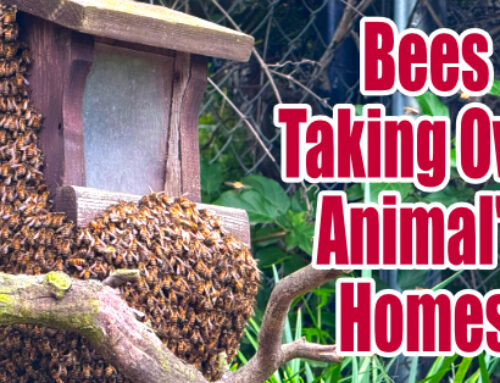One of the terms used in Bee Removal that we frequently use in our day to day operations is the term “flight pattern“. So what is a flight pattern and why is it such an important term. In general, the phrase “flight pattern” is used to describe the way a group of bees are flying. There are a few different types of flight patterns:
First Flight Pattern: Scouting Behavior
One example is called scouting behavior. Scout bees are a type of worker bee that is tasked with finding a new home for swarm that is getting ready to leave an existing beehive. Before that swarm splits from an existing hive, scout bees will go out into the environment and look for a new place to set up a new hive. While these scout bees are looking for their new home, they tend to look as though they are drifting in a variety of different places. Often this looks like a few dozen flying around an entire side of a roofline or along the eaves of a home. Whenever a customer calls us and says they a bunch of bees drifting around a variety of different places, my first hunch is that they are describing scouting behavior. If the bees are not flying into a specific pathway or spot, and instead just flying in a broad general area, there is a good chance that they are scout bees. In the video below, we can see an example of this when some scout bees invaded a garage in La Mesa
Second Flight Pattern: Flight Paths
Another type of flight pattern we refer to often is called a “flight path”. This is often used to describe the direction or path a swarm will follow when leaving an existing hive. We use the term to describe the phenomenon of when a home or business repeatedly gets new swarms on their property repeatedly. Even though they don’t have a hive on their property, there may be one nearby that is getting ready to produce a swarm. For whatever reason, those swarms that leave seem to follow a similar path each time they leave and end up flying in the same direction. Its frustrating for these property owners because it means the chance of a swarm landing is much higher than a property that isn’t in the line of a flight path. Until that “Mother Hive” is found and dealt with, the chance of re infestation increases for repeated bee problems along that flight path. So why do these swarms follow a flight pattern? Some people speculate that they are sensitive to the earths magnetic field, but no one really knows for certain. Take a look at the following graph that can help illustrate what a flight path might look like if we could view it from above.
Third Flight Pattern: Bee Infestation
The last example of a flight pattern we will discuss in the blog is the flight pattern of a bee infestation. This is a super important flight pattern to recognize because it is usually an indicator that bees have infested a specific structure. What this will look like is dozens of bees going in and out of one very specific area. It could be in and out of an attic vent hole. Or it could be a crack or gap in a stucco or wood wall. Under eaves in a roofline or any area where a wire or pipe enters a home (that hasn’t been sealed properly). Often we see flight patterns where bees have infested chimneys, owl boxes, birdhouses, and irrigation boxes. Finding the flight pattern where bees are entering a structure is important because it reveals to our technician that there is an actual infestation, an not just scout bees. Below is an example of what the flight pattern would look like when you have an infestation.
The patterns of bee flight activity are an important thing for our technician to discern. Its how we tell if our customers have a bee problem or not. Once we spot the flight pattern of an infestation we can educate our customers that the activity they are seeing on the outside is only a fraction of the amount of bees that are building a hive on the inside. In short, its one of the many ways we are able to determine if there is a hive or swarm inside the structure, without having to open the structure.
That’s why whenever a customer calls us and doesn’t know how bees are getting into their home, we always recommend they go outside and look at the exterior of their home. I advise them to look along the entire perimeter of the home. Walls, rooflines, chimneys, vents…any areas that have gaps, holes or cracks that would allow a colony to infest. Once they spot the flight pattern of the bees going in and out of a specific spot, they’ll know where the infestation is occurring and that’s how the bees are getting inside.








